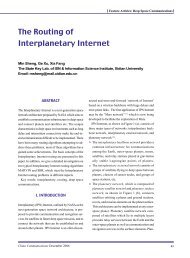Trend in Optical Fibers and Cables for Fiber-To-The-Home
Trend in Optical Fibers and Cables for Fiber-To-The-Home
Trend in Optical Fibers and Cables for Fiber-To-The-Home
You also want an ePaper? Increase the reach of your titles
YUMPU automatically turns print PDFs into web optimized ePapers that Google loves.
decreas<strong>in</strong>g the number of manufactur<strong>in</strong>g process <strong>and</strong><br />
reduc<strong>in</strong>g the cable diameter. For easy <strong>in</strong>stallation,<br />
the cable has been designed so as to take the fiber out<br />
easily. <strong>The</strong> Ø0.5-mm optical fiber described <strong>in</strong> the<br />
previous section also will be employed <strong>in</strong> the cable.<br />
<strong>The</strong> cable can be separated off the support<strong>in</strong>g wire<br />
without special tools thanks to the notch between the<br />
support<strong>in</strong>g wire <strong>and</strong> the cable <strong>in</strong> order to improve the<br />
h<strong>and</strong>l<strong>in</strong>g <strong>for</strong> the <strong>in</strong>stallation. In addition, the fiber<br />
can easily be taken out the cable thanks to the notch<br />
Feature Articles: <strong>Optical</strong> <strong>Fiber</strong> Communications<br />
Table.3 Characteristics ofØ0.5-mm optical fiber. <strong>in</strong> the center of the cable.<br />
Central value <strong>The</strong> cable size has been reduced to 5 mm<br />
Attenuation<br />
1.31 µm 0.340 dB/km 2 mm. <strong>The</strong> strength member is made of<br />
1.55 µm 0.193 dB/km the plastic material. <strong>The</strong> sheath has good<br />
H<strong>and</strong>l<strong>in</strong>g property<br />
flame-resistance <strong>and</strong> reduced environmental<br />
burdens by employ<strong>in</strong>g non-halogen<br />
material.<br />
VII. AERIAL CABLE<br />
Aerial cables are popular <strong>in</strong> Japan. <strong>The</strong><br />
length of an aerial cable on one drum<br />
should be elongated to reduce connection<br />
po<strong>in</strong>ts of the cables <strong>for</strong> <strong>in</strong>stallation<br />
cable to a subscriber conta<strong>in</strong>s one optical fiber as<br />
cost reduction. In addition the cable should be<br />
shown <strong>in</strong> Fig.9. <strong>The</strong> drop cable has been designed <strong>in</strong><br />
consideration of cost reduction <strong>and</strong> easy <strong>in</strong>stallation.<br />
<strong>The</strong> cost reduction of the cable has been achieved by<br />
light <strong>in</strong> weight <strong>for</strong> easy <strong>in</strong>stallation. <strong>The</strong> key<br />
po<strong>in</strong>ts of the cable design are described as follows.<br />
[13] 1.55 µm 3.8 dB<br />
Crush test 490 N/10cm<br />
<strong>Fiber</strong> strength<br />
Connection effect<br />
1.55 µm<br />
20 %/m<strong>in</strong><br />
1.55 µm<br />
0.01 dB<br />
5.2 GPa<br />
36 dB<br />
Temperature depen<br />
dence of optical loss<br />
-30 1.55 µm




